

For discovering and exploring the brand, I conducted a analysis of the history, mission, and business model of Chloé to understand its position as a luxury fashion brand. I learned about its founding by Gaby Aghion, its evolution through the decades, and its commitment to sustainability and women empowerment.
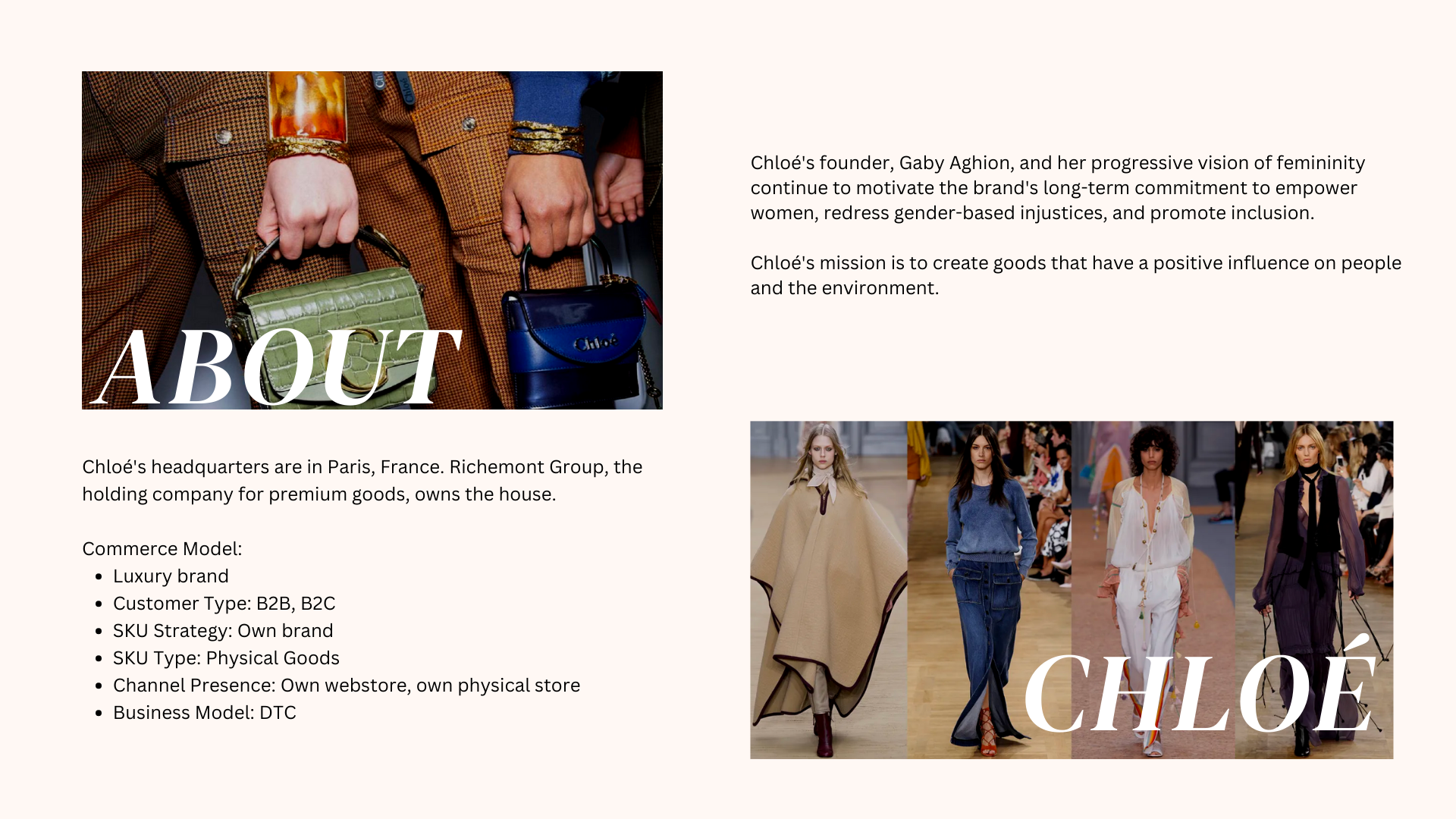
I developed a business model canvas to represent the most essential characteristics of Chloé's operations, including its value proposition, customer segments, key activities, channels, revenue streams, and cost structure. This allowed for mapping the brand's operation both in the physical and digital environments in a concise manner.
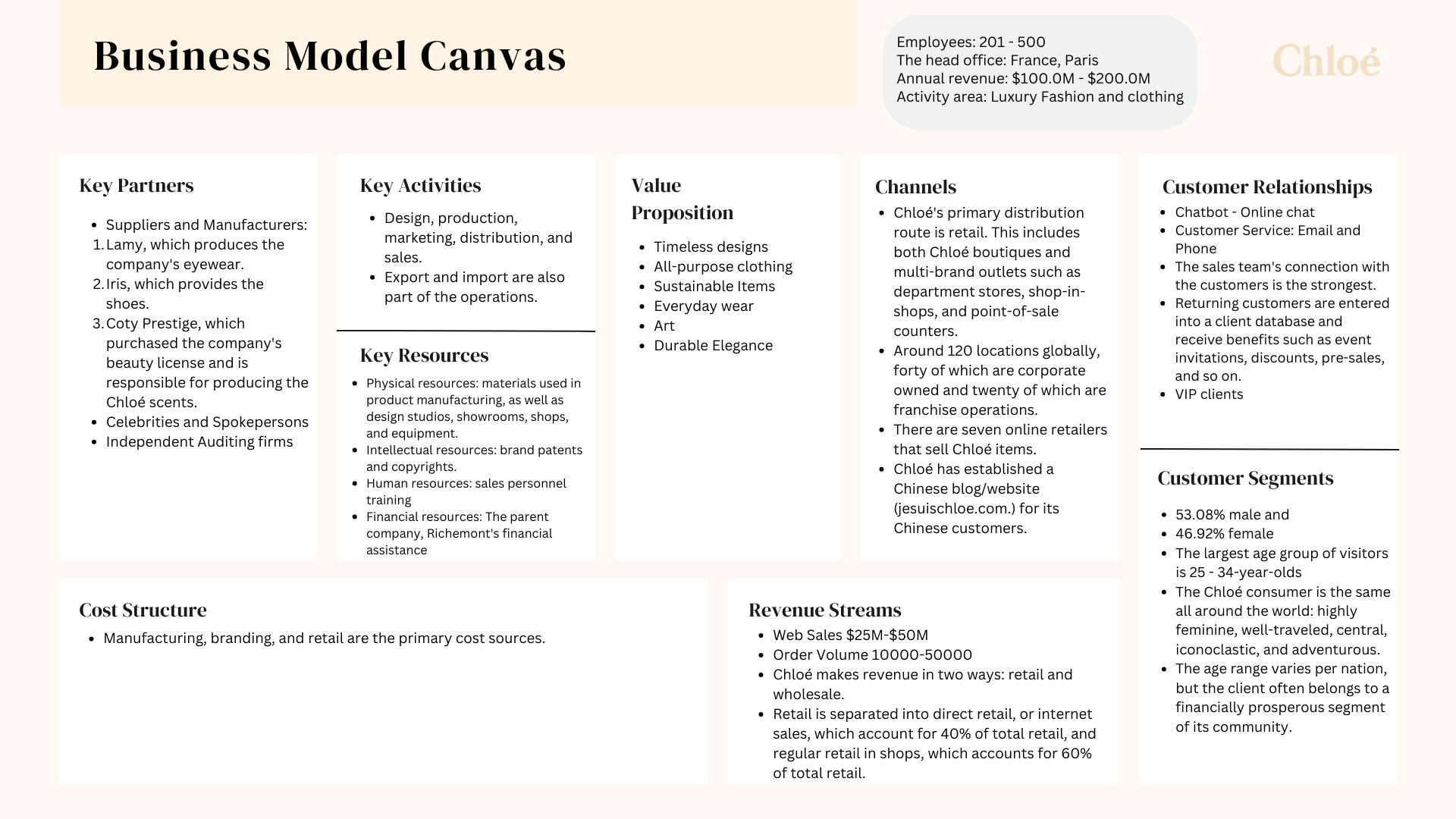
I also examined what sets Chloé apart as an e-business. Its combination of luxury and digital technology, particularly customer experience customization and frictionless omnichannel retailing, sets it apart from other luxury brands. I placed emphasis on Chloé's customer value proposition, how it conveys exclusivity, fashion, and better customer service through its digital channels.
Chloé is a luxury fashion challenger with an ambition to transcend traditional e-business norms. I made a competitive comparison of Chloé's online presence, technological integration, and sustainability with its key competitors, Prada, Celine, and Fendi.
While Chloé leads in sustainability with its B Corp status and initiatives in ethical fashion, it lags behind Prada and Fendi when it comes to technological integration and digital engagement.
Compared to competitors who are using CRM systems, interactive billboards, and high-end mobile apps, Chloé has a less widespread online presence. However, its strong brand values, client relationships, and vision for sustainable luxury remain key differentiators in the competitive marketplace.
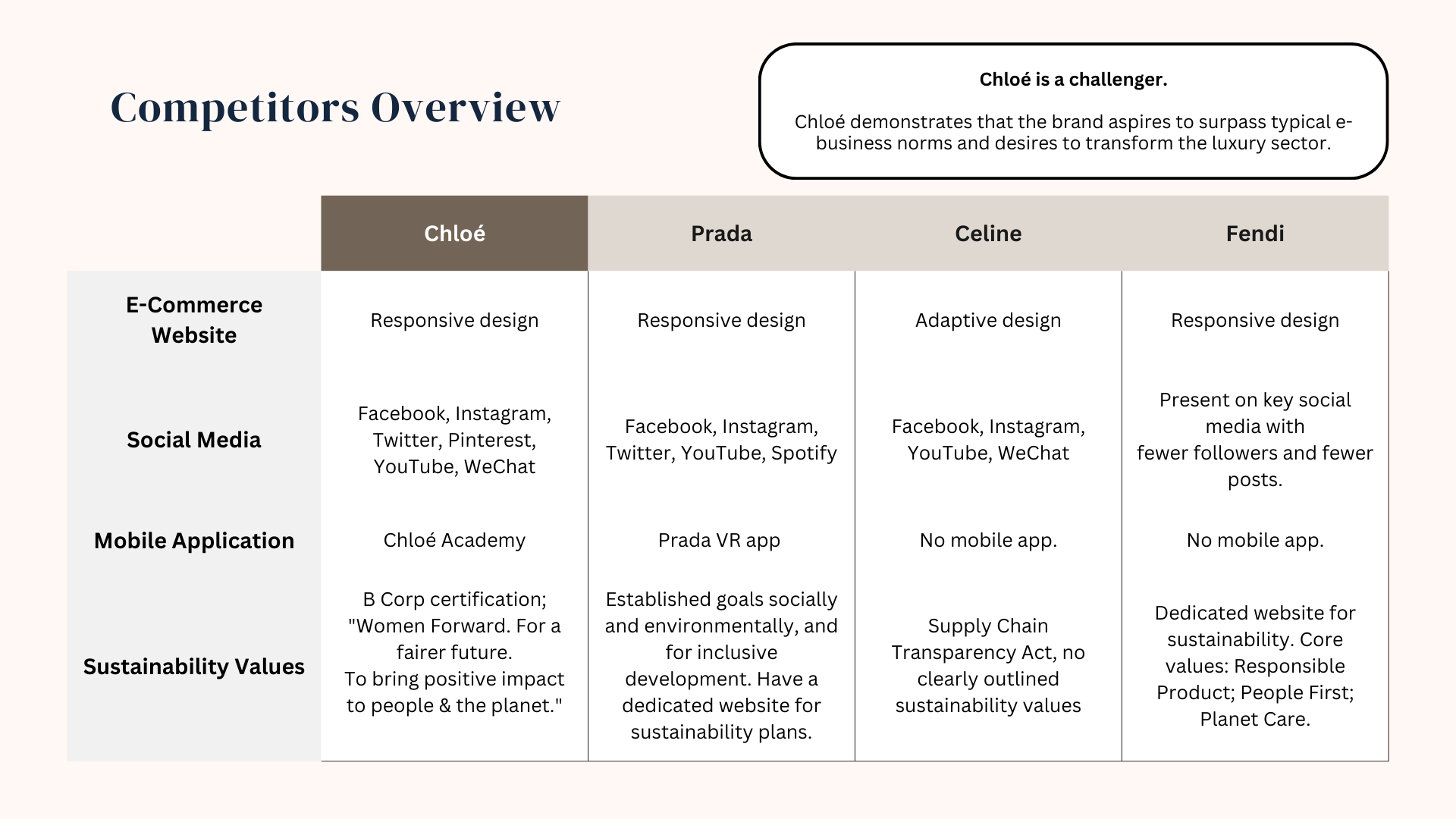
Chloé’s digital ecosystem is strong but could benefit from improved search optimization and exploring untapped marketing channels. The brand uses Microsoft Advertising for CPC campaigns and Akamai mPulse for website optimization. Hotjar helps track user behavior, while Akamai ensures content delivery and security.
The site receives 1.1M monthly visits, with a 52.41% bounce rate, primarily from the U.S., U.K., France, Japan, and Australia, aged 25-34 and interested in fashion. Most traffic comes from organic search (65.74%) and YouTube leads social media traffic. Chloé ranks well on Google but could enhance local store visibility. The brand scores an A for eco-sustainability, outperforming the industry’s average.
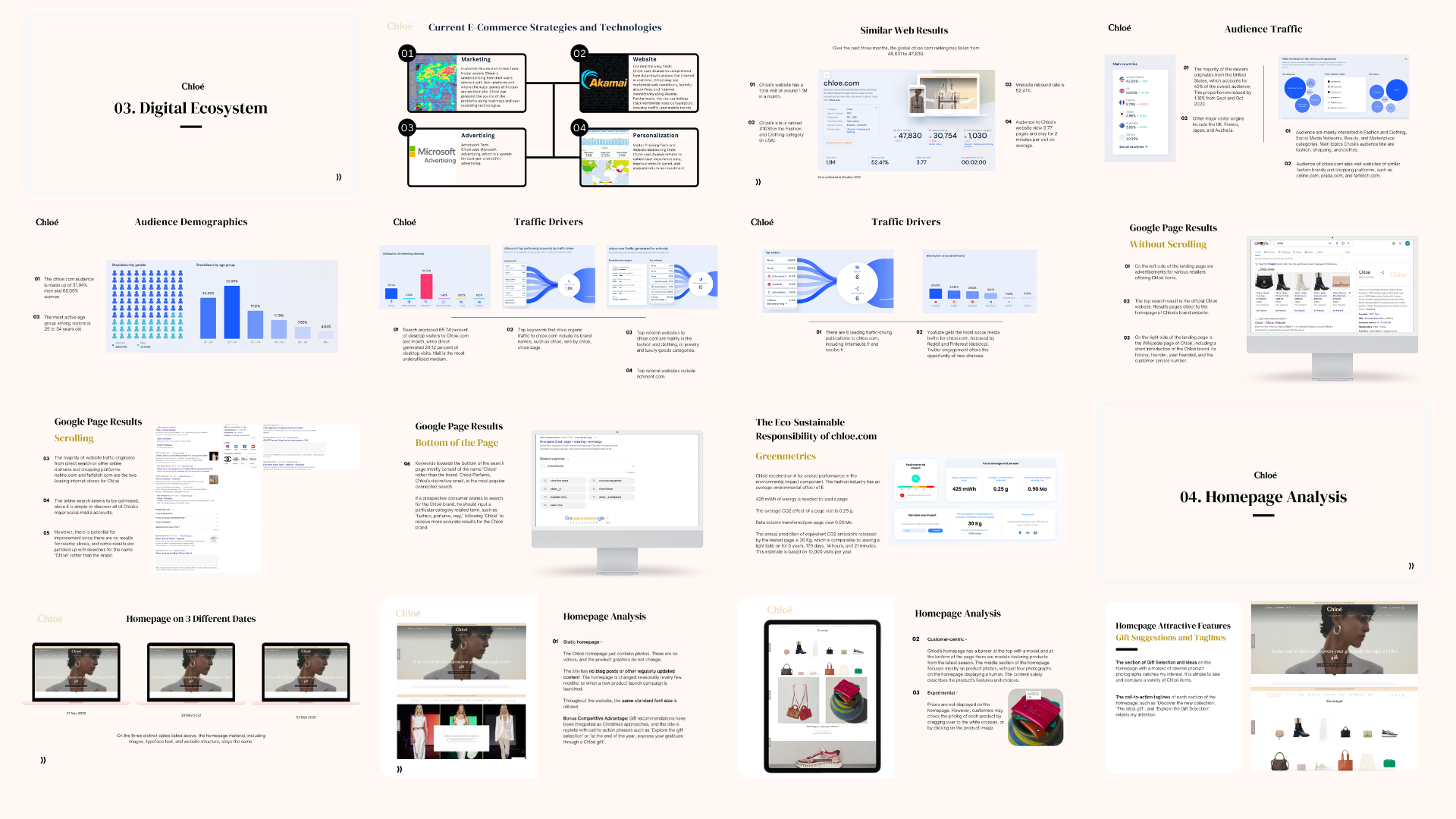
Chloé's homepage is uniform on various dates, with static images and no blog content or videos, but updates for new product releases. The customer-centric design includes models and product images with few lifestyle aspects. Prices are not shown on the homepage; customers have to hover or click to see them. Gift suggestions and call-to-action messages such as "Explore the Gift Selection" make the page interesting. A sliding banner contains promotions and new arrivals.
Product pages have detailed views with several angles, the option to zoom in, and expandable description panels. Size guides can be viewed and are geographically based for the shopper. Shopping online is easy, with the option to verify availability in stores or purchase as a guest or member. Payment can be done via credit cards, PayPal (with instalment options), and cash on delivery on orders below €750. Free shipping covers both express and regular shipping.
Account creation makes the users qualify for services like wish lists and order tracking. After-sales support is also available from Chloé in the form of return within 14 days, repair, and trace of return. Despite the site being simple and well-designed, there could be certain diversity in content and optimization of search.
Chloé's internal mobile app, Chloé Academy, connects the brand's geographically dispersed employees and offers a mobile-first personalized experience. It helps standardize customer service globally and provides an avenue for the sales team to connect with the stylist community. It is accessible on mobile and iPad and enables employees to access product information and reach the creative department from anywhere. This app is for Chloé employees exclusively.

Chloé's website is fully responsive, and there is instant and smooth browsing across all devices. Product presentation is enhanced with the use of high-quality images, but product videos and 360-degree views are not available. The website is helpful with functionalities such as product size guides and wishlist, and navigation is simple with minimal clicks for adding products to the shopping basket. Customer support is available by email and phone but no live chat functionality is offered.
Cross-channel functions like availability check in stores and returns are supported on the site, which improves the omnichannel experience. There remains an opportunity to enhance the in-store experience through more advanced digital capabilities, e.g., interactive screens, and online customer service through features like live sales support and chatbots.
Chloé's target market is high-net-worth individuals between 18-45 years old who are interested in new content, particularly visual and video content. The business utilizes platforms like Instagram, Pinterest, YouTube, Facebook, and Twitter in an attempt to access the market, with a focus on lifestyle and design. In order to actually target potential consumers, however, Chloé must improve utilization of short video contents, particularly through Instagram Stories.
On platforms like Weibo, Chloé likes geo-location features for marketing and follower-to-member conversion. Pinterest is not widely used today but can connect with Generation Z through innovative content and brand awareness. Instagram possesses decent e-commerce features, and Facebook possesses minimalistic shopping and engagement features.
To enhance social media performance, Chloé can enhance Instagram by pinning its best posts and adding product links to posts. Facebook can be enhanced by adding chatbots to provide customer support 24/7, posting behind-the-scenes material, and using Facebook Stories for promoting the brand. Chloé must also move to TikTok to reach young customers by carrying out AR campaigns and user-generated content for better engagement.
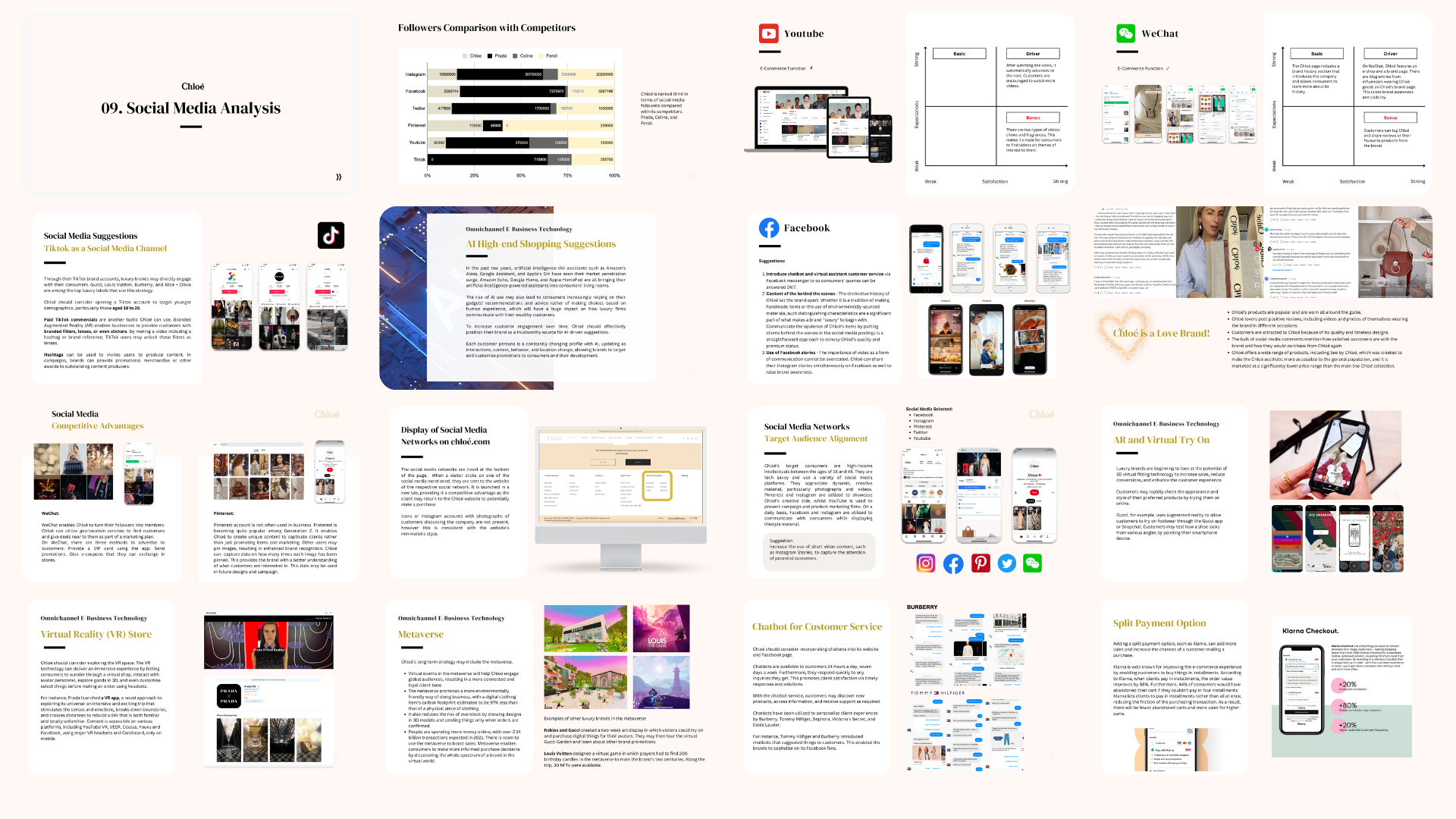
Based on my research and analysis above, I suggested the following technologies that Chloé can implement to enhance its online experience.
Split payment feature : Split payment feature, like Klarna, would reduce purchase friction and boost sales. Klarna supports installment payments, which boosts order value by 68% and cart abandonment reduces by 44%. This can drive more value purchases and lower cart abandonment.
Customer service chatbot : Having chatbots on the website and Facebook page would improve customer service by providing 24/7 support. Chatbots allow consumers to discover products, gain information, and get instant responses, making the shopping process more personalized, as is evident with retailers like Burbury and Tommy Hilfiger.
AI shopping suggestions : Adoption of AI-driven product suggestions would allow Chloé to build a tailored shopping experience. With AI and consumer data, Chloé would be able to adapt on the basis of individual behavior, making suggestions and offers at a personal level to engage consumers.
Metaverse integration : Chloé is able to experiment with the metaverse as a long-term model. The metaverse virtual events will allow participation from around the world and generate an environmentally friendly business model. This strategy also allows customers to make educated purchase decisions by shopping through virtual collections, similar to other luxury brands.
Virtual reality store : Placing VR technology would give consumers a total shopping experience, allowing them to interact with 3D products and avatars. This could be an innovative, sensory shopping experience that blends the physical and digital world, such as Prada's VR app.
Augmented Reality and virtual try-ons : AR technology could significantly improve the online shopping experience. By allowing customers to try on items virtually, Chloé would be able to increase conversion rates and improve customer satisfaction, as shown by the virtual try-on capabilities of Gucci.
Conversational luxury retailing via voice commerce : Utilization of voice commerce through voice devices such as Google Home and Amazon Echo would create seamless and effective shopping experiences. It would enhance convenience and confidence levels among premium consumers, allowing them to make speedy purchases through voice commands.
Visual search and image recognition : Visual search and image recognition technology combined would allow customers to shop by photograph upload. It would do away with keyword searching and allow customers to find easily related products, thereby generating interaction and satisfaction.
The final product of this project is a thorough 97-page report with analysis and creative recommendations. The report presents a detailed profile of Chloé's current online presence and recommends strategic improvements through advancing technologies. The report is designed to enhance shopping experience online, increase customer interaction, and drive sales to keep Chloé ahead in the evolving luxury retail environment.
View the complete report by clicking on the project link in the following section.